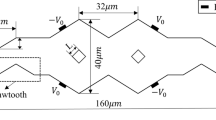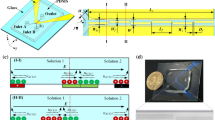Abstract
The traditional electroosmotic microfluidic mixers generally involve microelectrodes embedded on the inner wall of microchannel, which increases the difficulty of microchip processing and reduces the functional flexibility inevitably. In this paper, we report the development of a novel microfluidic mixer with straight microchannel based on the light-actuated oscillating electroosmosis in low-frequency sinusoidal AC electric field. The mixing performance is investigated by solving the coupled system of flow field, electric field and concentration field using finite element method. The formation mechanism of a pair of rotating vortices at both edges of the optical virtual electrode and the mixing mechanism of fluid samples are revealed. The effect of several key parameters including external applied potential, electric field frequency and inlet mean velocity on the mixing performance is also explored. The current technique provides a new method for efficient mixing of fluids in modern microfluidic analysis systems, and could potentially promote the comprehensive integration of functions, simplifying structure and reducing manufacturing costs of microchip.










Similar content being viewed by others
References
Ahmed F, Kim KY (2017) Parametric study of an electroosmotic micromixer with heterogeneous charged surface patches. Micromachines (Basel) 8:199. https://doi.org/10.3390/mi8070199
Ai Y, Zeng Z, Qian S (2014) Direct numerical simulation of AC dielectrophoretic particle-particle interactive motions. J Colloid Interface Sci 417:72–79. https://doi.org/10.1016/j.jcis.2013.11.034
Alipanah M, Ramiar A (2017) High efficiency micromixing technique using periodic induced charge electroosmotic flow: a numerical study. Colloids Surf A 524:53–65. https://doi.org/10.1016/j.colsurfa.2017.04.020
Basati Y, Mohammadipour OR, Niazmand H (2019) Numerical investigation and simultaneous optimization of geometry and zeta-potential in electroosmotic mixing flows. Int J Heat Mass Transf 133:786–799. https://doi.org/10.1016/j.ijheatmasstransfer.2018.12.159
Bera S, Bhattacharyya S (2013) On mixed electroosmotic-pressure driven flow and mass transport in microchannels. Int J Eng Sci 62:165–176. https://doi.org/10.1016/j.ijengsci.2012.09.006
Chen X, Li T (2017) A novel passive micromixer designed by applying an optimization algorithm to the zigzag microchannel. Chem Eng J 313:1406–1414. https://doi.org/10.1016/j.cej.2016.11.052
Chen H, Zhang Y, Mezic I, Meinhart C, Petzold L (2003) Numerical simulation of an electroosmotic micromixer. ASME Int Mech Eng Congr. https://doi.org/10.1115/imece2003-55017
Chen J-L, Shih W-H, Hsieh W-H (2013) AC electro-osmotic micromixer using a face-to-face, asymmetric pair of planar electrodes. Sens Actuators B Chem 188:11–21. https://doi.org/10.1016/j.snb.2013.07.012
Chen X, Li T, Zeng H, Hu Z, Fu B (2016) Numerical and experimental investigation on micromixers with serpentine microchannels. Int J Heat Mass Transf 98:131–140. https://doi.org/10.1016/j.ijheatmasstransfer.2016.03.041
Chen H, Gao Y, Petkovic K, Yan S, Best M, Du Y, Zhu Y (2017a) Reproducible bubble-induced acoustic microstreaming for bead disaggregation and immunoassay in microfluidics. Microfluid Nanofluid 21:30. https://doi.org/10.1007/s10404-017-1870-2
Chen L, Deng Y, Zhou T, Pan H, Liu Z (2017b) A novel electroosmotic micromixer with asymmetric lateral structures and DC electrode arrays. Micromach Basel 8:105. https://doi.org/10.3390/mi8040105
Chen H, Chen C, Bai S, Gao Y, Metcalfe G, Cheng W, Zhu Y (2018) Multiplexed detection of cancer biomarkers using a microfluidic platform integrating single bead trapping and acoustic mixing techniques. Nanoscale 10:20196–20206. https://doi.org/10.1039/c8nr06367b
Chiou PY, Ohta AT, Wu MC (2005) Massively parallel manipulation of single cells and microparticles using optical images. Nature 436:370–372. https://doi.org/10.1038/nature03831
Cho C-C, Co-K C, Yau H-T (2015) Mixing of electrokinetically-driven power-law fluids in zigzag microchannels. Int J Numer Methods Heat Fluid Flow 25:391–399. https://doi.org/10.1108/hff-04-2013-0107
Cho CC, Chen CL, Chen CK (2012b) Mixing of non-Newtonian fluids in wavy serpentine microchannel using electrokinetically driven flow. Electrophoresis 33:743–750. https://doi.org/10.1002/elps.201100496
Cho C-C, Chen C-L, Co-K C (2012a) Flow characteristics and mixing performance of electrokinetically driven non-Newtonian fluid in contraction–expansion microchannel. Rheol Acta 51:925–935. https://doi.org/10.1007/s00397-012-0650-x
Deng Y, Zhou T, Liu Z, Wu Y, Qian S, Korvink JG (2018) Topology optimization of electrode patterns for electroosmotic micromixer. Int J Heat Mass Transf 126:1299–1315. https://doi.org/10.1016/j.ijheatmasstransfer.2018.06.065
Fang F, Zhang N, Liu K, Wu Z-Y (2014) Hydrodynamic and electrodynamic flow mixing in a novel total glass chip mixer with streamline herringbone pattern. Microfluid Nanofluid 18:887–895. https://doi.org/10.1007/s10404-014-1479-7
Goovaerts R, Smits W, Desmet G, Denayer J, De Malsche W (2012) Combined improved mixing and reduced energy dissipation by combining convective effects and lamination. Chem Eng J 211–212:260–269. https://doi.org/10.1016/j.cej.2012.09.024
Hu S, Zhao Y, Wang Q (2015) Design and simulation of the angle-ended fiber integrated into optoelectronic tweezers chip. Optik 126:3240–3244. https://doi.org/10.1016/j.ijleo.2015.07.111
Jain M, Rao A, Nandakumar K (2013) Numerical study on shape optimization of groove micromixers. Microfluid Nanofluid 15:689–699. https://doi.org/10.1007/s10404-013-1169-x
Ji Y, Deng Y, Liu Z, Zhou T, Wu Y, Qian S (2017) Optimal control-based inverse determination of electrode distribution for electroosmotic micromixer. Micromachines (Basel) 8:247. https://doi.org/10.3390/mi8080247
Liang W, Liu N, Dong Z, Liu L, Mai JD, Lee G-B, Li WJ (2013) Simultaneous separation and concentration of micro- and nano-particles by optically induced electrokinetics. Sens Actuators A 193:103–111. https://doi.org/10.1016/j.sna.2013.01.020
Lin W-Y, Lin Y-H, Lee G-B (2009) Separation of micro-particles utilizing spatial difference of optically induced dielectrophoretic forces. Microfluid Nanofluid 8:217–229. https://doi.org/10.1007/s10404-009-0457-y
Liu W, Ren Y, Tao Y, Yao B, Li Y (2018) Simulation analysis of rectifying microfluidic mixing with field-effect-tunable electrothermal induced flow. Electrophoresis 39:779–793. https://doi.org/10.1002/elps.201700234
Liu W, Ren Y, Xue R, Song C, Wu Q (2020) On ion transport regulation with field-effect nonlinear electroosmosis control in microfluidics embedding an ion-selective medium. Electrophoresis 41:778–792. https://doi.org/10.1002/elps.201900408
Maadi M, Golmarz TP (2014) Investigation of mixing and simulation of an electroosmotic micromixer. J Mech Sci Technol 28:3223–3230. https://doi.org/10.1007/s12206-014-0732-z
Mahapatra B, Bandopadhyay A (2020) Electroosmosis of a viscoelastic fluid over non-uniformly charged surfaces: effect of fluid relaxation and retardation time. Phys Fluids 32:032005. https://doi.org/10.1063/5.0003457
Manz A, Eijkel JCT (2001) Miniaturization and chip technology. What can we expect? Pure Appl Chem 73:1555–1561
Mirzajani H, Cheng C, Wu J, Ivanoff CS, Najafi Aghdam E, Badri Ghavifekr H (2016) Design and characterization of a passive, disposable wireless AC-electroosmotic lab-on-a-film for particle and fluid manipulation. Sens Actuators B Chem 235:330–342. https://doi.org/10.1016/j.snb.2016.05.073
Ng WY, Goh S, Lam YC, Yang C, Rodriguez I (2009) DC-biased AC-electroosmotic and AC-electrothermal flow mixing in microchannels. Lab Chip 9:802–809. https://doi.org/10.1039/b813639d
Novotny J, Foret F (2017) Fluid manipulation on the micro-scale: basics of fluid behavior in microfluidics. J Sep Sci 40:383–394. https://doi.org/10.1002/jssc.201600905
Pei-Yu C, Ohta AT, Jamshidi A, Hsin-Yi H, Wu MC (2008) Light-actuated AC electroosmosis for nanoparticle manipulation. J Microelectromech Syst 17:525–531. https://doi.org/10.1109/jmems.2008.916342
Petkovic K, Metcalfe G, Chen H, Gao Y, Best M, Lester D, Zhu Y (2016) Rapid detection of Hendra virus antibodies: an integrated device with nanoparticle assay and chaotic micromixing. Lab Chip 17:169–177. https://doi.org/10.1039/c6lc01263a
Ren Y, Liu W, Tao Y, Hui M, Wu Q (2018) On AC-field-induced nonlinear electroosmosis next to the sharp corner-field-singularity of leaky dielectric blocks and its application in on-chip micro-mixing. Micromachines (Basel) 9:102. https://doi.org/10.3390/mi9030102
Seo HS, Han B, Kim YJ (2012) Numerical study on the mixing performance of a ring-type electroosmotic micromixer with different obstacle configurations. J Nanosci Nanotechnol 12:4523–4530. https://doi.org/10.1166/jnn.2012.6188
Shang X, Huang X, Yang C (2015) Mixing enhancement by the vortex in a microfluidic mixer with actuation. Exp Thermal Fluid Sci 67:57–61. https://doi.org/10.1016/j.expthermflusci.2014.10.017
Song Y, Wang C, Li J, Li D (2019) Vortex generation in electroosmotic flow in a straight polydimethylsiloxane microchannel with different polybrene modified-to-unmodified section length ratios. Microfluid Nanofluid 23:24. https://doi.org/10.1007/s10404-019-2191-4
Wang C, Song Y, Pan X (2020) Electrokinetic-vortex formation near a two-part cylinder with same-sign zeta potentials in a straight microchannel. Electrophoresis 41:793–801. https://doi.org/10.1002/elps.201900474
Wen CY, Liang KP, Chen H, Fu LM (2011) Numerical analysis of a rapid magnetic microfluidic mixer. Electrophoresis 32:3268–3276. https://doi.org/10.1002/elps.201100254
Xu Z, Yang Y, Vadillo D, Ruan X, Fu X (2012) A mathematical model of mixing enhancement in microfluidic channel with a constriction under periodic electro-osmotic flow. Appl Phys Lett 100:041907. https://doi.org/10.1063/1.3678037
Yap LW et al (2017) Bifunctional plasmonic-magnetic particles for an enhanced microfluidic SERS immunoassay. Nanoscale 9:7822–7829. https://doi.org/10.1039/c7nr01511a
Zhao Y, Hu S, Wang Q (2013) Simulation and analysis of particle trajectory caused by the optical-induced dielectrophoresis force. Microfluid Nanofluid 16:533–540. https://doi.org/10.1007/s10404-013-1246-1
Zhou T, Xu Y, Liu Z, Joo SW (2015) An enhanced one-layer passive microfluidic mixer with an optimized lateral structure with the Dean effect. J Fluids Eng. https://doi.org/10.1115/1.4030288
Zhu X, Yin Z, Ni Z (2011) Dynamics simulation of positioning and assembling multi-microparticles utilizing optoelectronic tweezers. Microfluid Nanofluid 12:529–544. https://doi.org/10.1007/s10404-011-0895-1
Acknowledgements
This work is funded by National Natural Science Foundation of China (Grant Nos. 61964006 and 52075138), Hainan Provincial Natural Science Foundation of China (Grant Nos. 519MS021 and 2019RC032).
Author information
Authors and Affiliations
Corresponding authors
Ethics declarations
Conflict of interest
The authors declared that they have no conflicts of interest to this work.
Additional information
Publisher's Note
Springer Nature remains neutral with regard to jurisdictional claims in published maps and institutional affiliations.
Supplementary Information
Below is the link to the electronic supplementary material.
Rights and permissions
About this article
Cite this article
Ding, H., Zhong, X., Liu, B. et al. Mixing mechanism of a straight channel micromixer based on light-actuated oscillating electroosmosis in low-frequency sinusoidal AC electric field. Microfluid Nanofluid 25, 26 (2021). https://doi.org/10.1007/s10404-021-02430-1
Received:
Accepted:
Published:
DOI: https://doi.org/10.1007/s10404-021-02430-1




